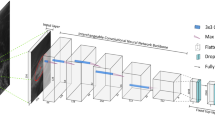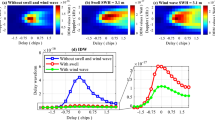Abstract
Ocean waves are complex systems with the contributions of wind waves and swells. The study on interaction mechanism between electromagnetic wave and actual sea surface is of significant importance in ocean remote sensing and engineering application, which is also helpful in the prediction and inversion of wave information. In this paper, an efficient model for estimating backscattering coefficient is built, considering the characteristics of the wind-wave regime based on the inverse wave age. The backscattering coefficient results have been verified by comparing with the data collected in Lingshan Island during the period of October and November 2014 at low grazing angles and the Ku-band measurements at moderate grazing angles. The results indicate perfect agreement (within about 2 dB) with field data. Deep learning is an excellent method that can be used not only for classification but also for inversion and fitting of non-linear functions. In order to simulate the application of actual radar detection and inversion technology, the inversion of significant wave height from actual sea surface backscattering coefficients train data sets has been performed by using deep learning technology. The accuracy of 99.01% has been achieved under the condition of three hidden layers and iterating 100 times. The root mean square errors of the test data sets are less than 0.10, which indicates that deep learning is available in the inversion of significant wave height.












Similar content being viewed by others
References
Andreas EL, Wang S (2007) Predicting significant wave height off the northeast coast of the United States. Ocean Eng 34(8–9):1328–1335
Chehri A, Jeon G, Choi B (2013) Link-quality measurement and reporting in wireless sensor networks. Sensors 13(3):3066–3076
Chong WZ, Chong YL (2015) Variation of the wave energy and significant wave height in the China Sea and adjacent waters. Renew Sust Energ Rev 43:381–387
Cuomo S, Michele PD, Piccialli F, Farina R (2013) A smart GPU implementation of an elliptic kernel for an ocean global circulation model. Appl Math Sci 7(61):3007–3021
Dee DP, Uppala SM, Simmons AJ, Berrisford P, Poli P, Kobayashi S, Andrae U, Balmaseda MA, Balsamo G, Bauer P (2011) The ERA-interim reanalysis: configuration and performance of the data assimilation system. Q J R Meteorol Soc 137(656):553–597
Elfouhaily T, Chapron B, Katsaros K, Vandemark D (1997) A unified directional spectrum for long and short wind-driven waves. J Geophys Res Oceans 102(C7):15781–15796
Franceschetti G, Iodice A, Riccio D, Ruello G, Siviero R (2002) SAR raw signal simulation of oil slicks in ocean environments. IEEE Trans Geosci Remote Sens 40(9):1935–1949
Goda Y (1999) A comparative review on the functional forms of directional wave spectrum. Coast Eng J 41(01):1–20
Hanley KE, Belcher SE, Sullivan PP (2010) A global climatology of wind-wave interaction. J Phys Oceanogr 40(6):1263–1282
Hwang PA, Ocampo-Torres FJ, García-Nava H (2012) Wind Sea and swell separation of 1D wave spectrum by a spectrum integration method. J Atmos Ocean Technol 29(1):116–128
Jeon G, Anisetti M, Lee J, Bellandi V, Damiani E, Jeong J (2009) Concept of linguistic variable-based fuzzy ensemble approach: application to interlaced HDTV sequences. IEEE Trans Fuzzy Syst 17(6):1245–1258
Jeon G, Anisetti M, Wang L, Damiani E (2016) Locally estimated heterogeneity property and its fuzzy filter application for Deinterlacing. Inf Sci 354:112–130
Jie G, Wang H, Fan J, Ma X (2018) SAR image classification via deep recurrent encoding neural networks. IEEE Trans Geosci Remote Sens 56(4):2255–2269
Jr WJP, Moskowitz L (1964) A proposed spectral form for fully developed wind seas based on the similarity theory of S. A. Kitaigorodskii. J Geophys Res 69(24):5181–5190
Kingma D, Ba J (2015) Adam: A Method for Stochastic Optimization. Proceedings of the 3rd International Conference on Learning Representations (ICLR 2015)
Kumar NK, Savitha R, Mamun AA (2017) Regional Ocean wave height prediction using sequential learning neural networks. Ocean Eng 129:605–612
Lygre A, Krogstad HE (1986) Maximum entropy estimation of the directional distribution in ocean wave spectra. J Phys Oceanogr 16(12):2052–2060
Nair V, Hinton GE (2010) Rectified linear units improve restricted boltzmann machines. In: Proceedings of the 27th International Conference on International Conference on Machine Learning (ICML 2010), p 807–814
Pan X, Jing W, Zhang X, Yuan M, Lu S, Zhong G (2018) A deep-learning model for the amplitude inversion of internal waves based on optical remote-sensing images. Int J Remote Sens 39(3):607–618
Panahi R, GK A, Shafieefar M (2015) Development of a bi-modal directional wave spectrum. Ocean Eng 105:104–111
Piccialli F, Cuomo S, Michele PD, Galletti A, Jung JJ (2017) IoT-based collaborative reputation system for associating visitors and artworks in a cultural scenario. Expert Syst Appl 79:101–111
Rikka S, Pleskachevsky A, Uiboupin R, Jacobsen S (2018) Sea state in the Baltic Sea from space-borne high-resolution synthetic aperture radar imagery. Int J Remote Sens 39(4):1256–1284
Schroeder L, Schaffner P, Mitchell J, Jones W (2003) AAFE RADSCAT 13.9-GHz measurements and analysis: wind-speed signature of the ocean. IEEE J Ocean Eng 10(4):346–357
Shang R, Wang J, Jiao L, Stolkin R, Li Y (2018) SAR targets classification based on deep memory convolution neural networks and transfer parameters. IEEE J-STARS 11(8):2834–2846
Soares CG (1991) On the occurence of double peaked wave spectra. Ocean Eng 18(1–2):167–171
Sze V, Chen YH, Yang TJ, Emer J (2017) Efficient processing of deep neural networks: a tutorial and survey. Proc IEEE 105(12):2295–2329
Thorsos EI (1988) The validity of the Kirchhoff approximation for rough surface scattering using a Gaussian roughness spectrum. J Acoust Soc Am 83(1):78–92
Thorsos EI, Jackson DR (1989) The validity of the perturbation approximation for rough surface scattering using a Gaussian roughness spectrum. J Acoust Soc Am 86(1):261–277
Toporkov JV, Brown GS (2000) Numerical simulations of scattering from time-varying, randomly rough surfaces. IEEE Trans Geosci Remote Sens 38(4):1616–1625
Torsethaugen K, Haver S (2004) Simplified double peak spectral model for ocean waves. The Fourteenth International Offshore and Polar Engineering Conference 3:76–84
Wu Z, Zhang J, Guo L (2009) An improved two-scale model with volumes scattering for the Dynamic Ocean surface. Prog Electromagn Res 89:39–56
Wu T, Wu Z, Wu J, Jeon G, Ma L (2018) Features of X-band radar backscattering simulation based on the ocean environmental parameters in China offshore seas. Sensors 18(8):2450
Zhang Y, Zhang J, Li X, Wu Z (2014) Modified GIT model for predicting wind-speed behavior of low-grazing-angle radar sea clutter. Chin Phys B 23(10):108402
Acknowledgments
The authors would like to express their sincere thanks to the members of the clutter research group in China Research Institute of Radiowave Propagation for their work on the sea clutter experiment. And the ocean environment parameters data have been kindly provided by the European Centre for Medium-Range Weather Forecasts (ECMWF), (https://www.ecmwf.int). This research was alos funded by the National Natural Science Foundation of China (No. 61571355 and No. 61601355), and the Pre-Research Foundation of China (No. FY1502802001).
Author information
Authors and Affiliations
Corresponding author
Additional information
Publisher’s note
Springer Nature remains neutral with regard to jurisdictional claims in published maps and institutional affiliations.
Rights and permissions
About this article
Cite this article
Wu, T., Cao, YH., Wu, ZS. et al. Deep learning for inversion of significant wave height based on actual sea surface backscattering coefficient model. Multimed Tools Appl 79, 34173–34193 (2020). https://doi.org/10.1007/s11042-019-07967-6
Received:
Revised:
Accepted:
Published:
Issue Date:
DOI: https://doi.org/10.1007/s11042-019-07967-6




